远射程风送式喷雾机气流场分布及喷雾特性试验
2018-01-09陈建泽宋淑然孙道宗洪添胜
陈建泽,宋淑然,孙道宗,洪添胜,3,4,5,张 龙
远射程风送式喷雾机气流场分布及喷雾特性试验
陈建泽1,宋淑然2,3,4,5※,孙道宗2,3,4,5,洪添胜1,3,4,5,张 龙2
(1. 华南农业大学工程学院,广州 510642;2. 华南农业大学电子工程学院,广州 510642; 3. 国家柑橘产业技术体系机械研究室,广州 510642;4. 广东省农情信息监测工程技术研究中心,广州 510642; 5. 广东省山地果园机械创新工程技术研究中心,广州 510642)
由于远射程风送式喷雾机的空间风场及喷雾特性尚未明确,该文利用风速测量定位网架,进行了远射程风送式喷雾机空间风场特性试验和喷幅试验。试验结果发现,远射程风送式喷雾机轴心上的纵向时均风速随采样点距喷嘴距离的增加而衰减,两者呈负对数关系,这一特征符合淹没射流的流速变化规律;远射程风送式喷雾机轴心方向同一采样点上的风速与风机供电频率之间呈线性正相关,决定系数最低为0.609 1;远射程风送式喷雾机的水平喷幅关于喷筒轴心方向左右对称;而垂直喷幅在喷筒轴心方向的上下方呈现为不对称;远射程风送式喷雾远射程风送式喷雾机的送风量及出风口气流的时均风速均与风机供电电源的频率成正比;采用纸卡法测量了喷雾机的水平作业幅宽,该试验样机的水平作业幅宽为22 m。卷吸引起的伯努利效应和附壁效应是形成垂直喷幅不对称的重要原因,采用喷筒仰角喷雾可消除此效应。研究结果为远射程风送式喷雾机的生产和使用提供理论基础与参考。
农业机械;喷雾;风速;远射程;风送;空间风场;喷幅;附壁效应
0 引 言
远射程风送式喷雾机喷雾作业时,从风机吹出的高速气流将雾滴送向远处靶标,同时,空间风场中的气流吹动靶标,靶标枝叶发生摇动,使雾滴附着在靶标作物的叶背与叶面[1]、果树树冠的外层和内膛[2],所以,风送式喷雾技术可减少雾滴的飘移,降低农药对环境污染的风险,被国际公认为是一种仅次于航空喷雾的高效地面施药技术,同时又是一种自动化程度高,防治效果好,环境污染少的先进施药技术[3]。
通过对风送式喷雾机结构的设计与优化,可以改善喷雾机的喷雾性能[4-6],近年来,自由湍流射流理论、相似理论与FLUENT软件等被用于喷雾机的设计及研究中,缩短了研究周期[7-12]。研究发现,雾滴在果树上的沉积分布主要受风机风量的影响,而风送式喷雾机风机的风量主要由风速来决定[13]。因此,风送式喷雾机风场的特性及风速的变化会直接影响果园中病虫害的防治效果。
国内外学者对果园风助式喷雾机的研究较多[14-22],这种风助式喷雾机的射程较短,适用于平原地区果园的植保作业;在对远射程风送式(也称炮塔式)喷雾机的研究中,则以穿透性[2,23]、雾滴沉积分布[24-27]、优化设计[28-29]和雾滴粒径变化规律的研究[30]较多。
当靶标与喷雾机间的距离较远、或喷施对象外形较为高大时,需借助于远射程的风送式喷雾机进行植保作业。例如,在种植高秆作物的坡地及山地,普通植保机具难以进入,田间喷雾作业效率低、劳动强度大。利用远射程风送式喷雾机(喷程可达20~50 m)可以解决这个问题,在坡顶,顺坡面向下风送喷药;在坡底,顺坡面向上风送喷药(2个方向上的喷程覆盖坡顶与坡底间的距离)。远射程风送式喷雾机的应用,大大提高了坡地或山地作物的喷雾作业效率。
因此,研究和开发高效的远射程风送式喷雾机具有良好的应用前景。目前在中国,远射程风送式喷雾机不仅可应用于农业植保领域,也应用于净化环境的除尘喷雾与抑尘喷雾中。基于此,本文重点研究远射程风送式喷雾机的空间风场及喷雾特性,为远射程风送式喷雾机的生产和使用提供理论基础与技术指导。
1 材料与方法
1.1 试验设备
试验用远射程风送式喷雾机,由河南万丰农林设备有限公司生产,试验样机中,10个空心锥喷嘴呈圆周状均匀分布在喷筒的圆形出风口边沿,10个喷嘴两两成组、分5组均匀安装在喷筒边沿的不同高度下[30]。
风场试验中使用的仪器设备有:AZ-8901风速计,风速测量范围0.4~35 m/s,分辨率0.01 m/s,准确度±2%;风速测量定位网架(自制)高3 m、宽2 m,网格大小为11 cm×11 cm,网格上铁丝半径1.25 mm;数字显微镜supereyes放大倍率1~300。
1.2 远射程风送式喷雾机空间风场特性试验
远射程风送式喷雾机空间风场特性试验分为射程、风速2个试验。利用风速测量定位网架,进行风场特性参数的测定。试验前先测定环境风速,环境风速小于0.5 m/s时方可进行试验。试验现场如图1所示。

图1 试验现场
1.2.1 水平射程试验
风送式喷雾机按实际使用高度放置,喷筒轴线为水平方向;启动喷雾机,当风机运转达到平稳时,用风速仪测定喷筒轴线方向上空间气流风速,当风速降低为2 m/s时,记录该点的空间位置,测量示意图如图2所示。其中在方向上,风速为2 m/s的点的坐标即为水平射程。在30~50 Hz范围内改变风机供电电源的频率,每间隔2 Hz重复上述测量过程。

1,4. 垂直方向上2 m∙s-1风速边界线 2,3. 水平方向上2 m∙s-1风速边界线
1.2.2 轴心上的纵向时均风速试验
在水平射程试验中,沿喷筒轴线(中线)方向上,从距喷嘴安装处水平距离=1 m处开始,每隔1 m进行采样,测量轴心上的纵向时均风速;在30~50 Hz范围内改变风机供电电源的频率,每间隔2 Hz重复上述测量过程。
1.3 喷幅试验
在与射程相垂直方向上的两侧测量风速,风速降低到2 m/s处的2点间的最大距离为喷幅,喷幅的大小体现了风送式喷雾机固定喷雾时,对水平目标的覆盖范围。试验前先测定环境风速,环境风速小于0.5 m/s时方可进行试验。测量时,将风速仪放在定位网架的某个定位点上,缓慢转动风速仪测量面,观察读数,以读数最大值的方向测量方向,风速稳定后读数,每个定位点上采样3次,以3次采样值的平均值作为该定位点的风速。
如图2所示,选取沿水平射程方向为轴正方向,、轴均处于水平面中,、、构成笛卡尔坐标系,在轴正方向的不同距离下,测量轴与轴的正负方向的气流速度,重复测量3次取平均值,获得4条由2 m/s风速点构成的边界线。在30~50 Hz范围内改变风机供电电源的频率,每间隔2 Hz重复上述测量过程。图2中,边界线2与3上坐标相同的2个点之间的最大距离即为水平喷幅;边界线1与4上坐标相同的2个点之间的最大距离即为垂直喷幅。
1.4 送风量试验
风送式喷雾机出风口的气流均速与出风口面积的乘积为送风量。体现了风送式喷雾机喷出的气流对风机前方所包容的空气的置换能力,影响雾滴的穿透性和雾滴在靶标上的有效附着。本文通过测量风筒出风口处的时均风速,计算获得送风量。试验前先测定环境风速,环境风速小于0.5 m/s时方可进行试验。
1.4.1 出风口风速采样点设置
在远射程风送式喷雾机的出风口处,取21个采样点,采样点分布在3个区域,在风筒出风口的圆心处布置1个采样点,在导流器的外边缘圆周上以及导流器外边缘与风筒内边缘的中间圆周上各均匀布置10个采样点,如图3所示。在每个采样点上,每间隔2 s测量风速,共测量5次,保证在出风口的面积上有100个以上的风速采样值,取这些采样值的均值作为出风口的时均气流风速。

1.风筒出风口内边缘 2.导流片 3.导流器外边缘 4.采样点
在22~50 Hz范围内改变风机供电电源的频率,每间隔4 Hz测量出风口风速,获得不同电源频率下风送式喷雾机出风口的时均气流速度。
1.4.2 送风量的计算
测量远射程风送式喷雾机出风口的半径,取3次测量的平均值为计算值,计算出风口的面积(m2)。
设出风口的时均风速为(m/s),出风口的面积为(m2),则喷雾机的送风量(m3/s)可由式(1)得出。
=(1)
1.5 水平作业幅宽测定试验
水平作业幅宽是指自喷嘴喷出的药液所能达到的有效距离,即在50 Hz的供电频率下,射程方向上,从喷嘴处到雾滴沉积为25滴/cm2[29]的最远位置间的距离,是评价风送式喷雾机作业效率的指标之一。
采用纸卡法,对喷雾机的水平作业幅宽进行测定,如图4所示。
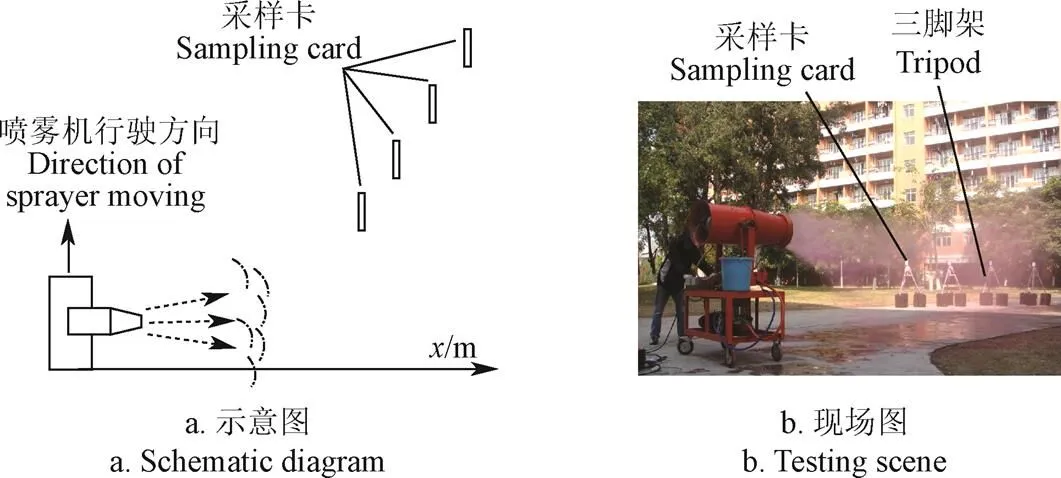
图4 喷雾作业幅宽试验
在喷雾机风筒轴线方向的区域内,距喷嘴不同距离布置三脚采样架,在采样架上夹放采样卡用于雾滴附着,采样卡对地高度与喷筒轴心距离地面的高度相同(本试验中,采样卡的夹放高度为1.53 m,与喷雾机风筒的轴线在同一水平面),每个采样卡上画有边长1 cm的正方形小格子。试验前先测定环境风速,环境风速小于0.5 m/s时方可进行喷雾试验。试验时,风送式喷雾机的运动速度为4 m/s,采用质量浓度为1%的罗丹明示踪剂进行喷雾,喷雾机通过雾滴采样区后,收集采样卡,用数字显微镜观察并读取采样卡上10个小格子内的雾滴个数(每平方厘米的雾滴个数),重复上述试验3次。
2 结果与分析
2.1 射程和轴心上的纵向时均风速
以送风距离为横坐标,轴心上的纵向时均风速为纵坐标,根据试验数据,绘制出不同供电频率下风速随采样点距喷嘴距离的变化曲线,如图5所示。采用Excel软件,同时利用对数函数、指数函数和幂函数对曲线进行数据拟合,结果发现,用指数函数和幂函数拟合方程的决定系数均比用对数函数拟合的决定系数小,故采用对数函数表示风速与距离间的关系。
以频率为50 Hz为例,拟合的对数函数为50=−8.13 ln+ 23.87,决定系数2=0.989。其中,50为风机供电频率50 Hz时风筒轴线方向上采样点的风速(m/s);为采样点距出风口的距离(m)。
从图5可以看出,在风机供电频率为46~50 Hz时,喷雾机的射程为13 m,随着频率的降低,射程也在减小。
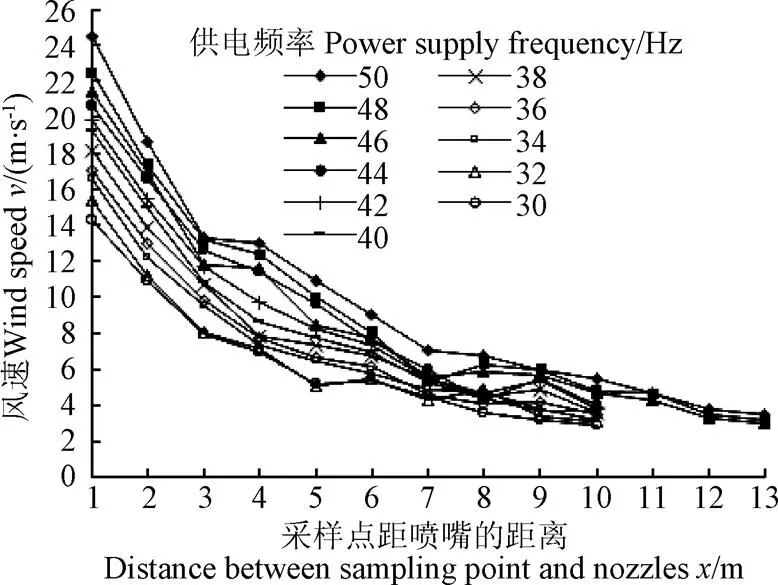
图5 不同供电频率下风速随采样点距喷嘴距离的变化
远射程风送式喷雾机轴心上的纵向时均风速随采样点距喷嘴距离的增加而衰减,两者呈负对数关系。这一特征符合淹没射流的流速变化规律。风机吹出的气流,流入了相同的空气介质中,该空气射流与周围静止空气发生动量和质量的交换,卷吸附近的空气一同流动,使得风送式喷雾机风场中空气的流量不断增加,流速不断减小。
因此,远射程风送式喷雾机的风场可分为2个部分:一是保持空气射流出口流速0不变的部分,即风场的射流核心区;其次是因卷吸与掺混作用,空气流速小于0的部分,即风场的射流核心与静止空气之间的部分。
在∈(1~3 m)区间内,风速下降的梯度较大。根据图5的试验结果,植保作业时,可以根据靶标的不同(靶标叶片受风摇摆应力不同)、或同一靶标不同生长期时(开花期与挂果期等)对风速的要求,选取合适的风机供电频率进行风送式喷雾作业,既保证喷雾的有效性与农药的利用率,又可避免风速不当引起的作物减产。
图6所示为在同一采样点上,风机的风速与供电频率之间带数据标记的折线图。
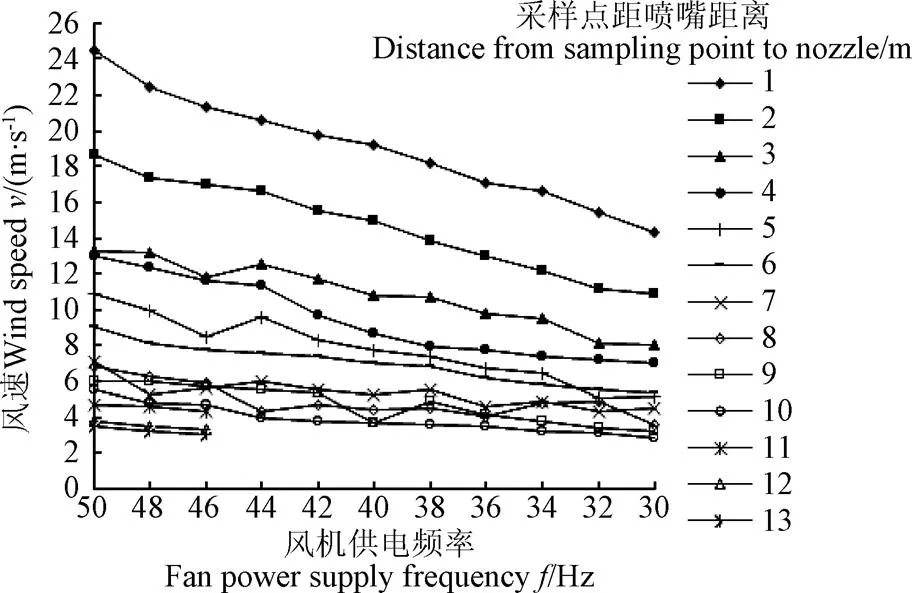
图6 采样点处风速随风机供电频率的变化
以采样点距喷嘴距离为1 m处为例,拟合的线性函数为1=−0.930+23.64,决定系数2=0.98,1为采样点距喷嘴距离为1 m处的风速(m/s),为供电频率(Hz)。结果表明,远射程风送式喷雾机同一采样点上的风速与供电频率之间呈线性相关,且具有较高的决定系数,最低为0.6091。这一特性使得喷雾作业更为灵活,即当出风口与靶标之间的距离受场地制约时(丘陵山地或不规整地块),可以采用调整风机的频率的方法,获得在靶标处满意的风速。
2.2 远射程风送式喷雾机的喷幅
远射程风送式喷雾机的风筒具有轴对称性,当喷筒在水平方向工作且无外在因素影响时,气流的流场为淹没射流,流场的分布也应具有轴对称性。表1所示为风机供电电源频率为50 Hz时,在喷筒轴线的左右(轴,即水平喷幅)及上下方向(轴,即垂直喷幅)的试验数据。
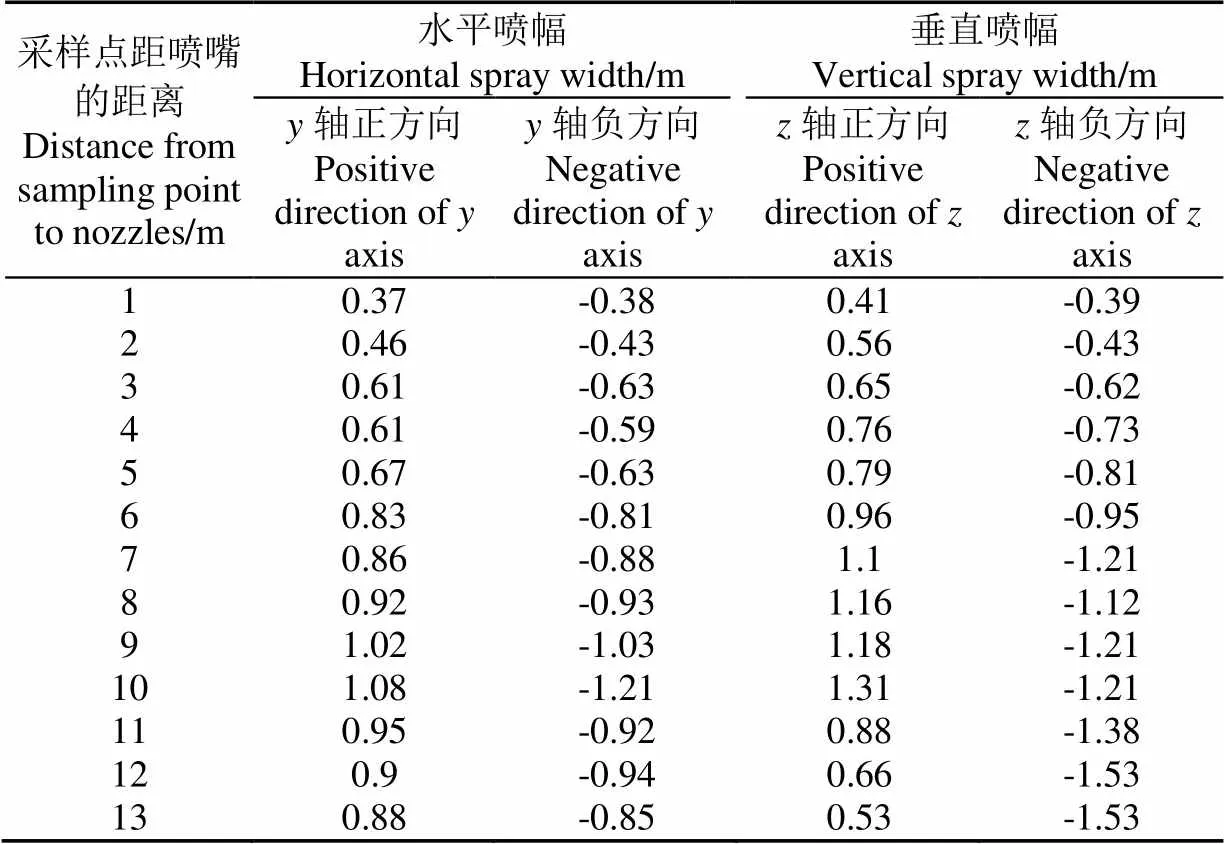
表1 风机供电电源频率为50 Hz时喷幅分布测定数据
由表1可以看出,在=10 m处,值最大,即水平喷幅为1.08−(−1.21)=2.29 m;同理,在=10 m处,值最大,即垂直喷幅为1.31−(−1.21)=2.52 m。
试验中通过改变风机的频率,获得了不同频率下的喷幅试验数据,绘制出如图7所示的2 m/s风速点构成的边界线。其中图7a为水平喷幅,关于喷筒轴心的左右方向对称,呈无固壁约束的自由湍流特性;图7b为垂直喷幅,关于喷筒轴心的上下方向出现了不对称。
喷雾机送风时,风机由外面吸入空气,空气经风机、喷筒和导流器加速及导向后由出风口吹出,流入空气中,形成空气淹没射流。随着该空气淹没射流与周围静止的空气发生动量和质量的交换,附近的静止空气不断被卷吸进入空气射流,随喷雾机喷出的气流一同流动。这一过程中,空气射流流量不断增加,流速不断减小和均化,空气射流的横断面不断扩大,使得喷雾机的喷幅呈现逐渐变宽的规律;随着送风距离的不断变大,气流速度变小,气流中2 m/s的风速点位置越来越靠近轴心,喷幅又呈现变窄的规律,如图7a所示。
在图7b中,采样点距离喷筒出风口8 m的区域内,各个风机供电频率下的垂直喷幅关于喷筒轴心仍然对称,这是由于在此区域内,气流的下方与地面的距离较大,气流与地面间的空间足以提供无固壁约束自由湍流卷吸所需的空气量,因此在这一区域内,气流的上下方速度变慢的规律一致,垂直喷幅上下对称。
采样点距离喷筒出风口8 m处,垂直喷幅出现了上下不对称,采样点距离喷筒出风口相同的处,喷筒轴线下方的风速大于上方的风速。

图7 不同供电频率下喷幅
当8 m时,随着空气射流横断面的增大,气流中的下方越来越接近地面。气流与地面的空间变小,气流下方被卷吸进入空气射流的空气量也随之减少,使空气射流的上下2个方向上在同一时间内因卷吸作用进入射流的空气质量不等,下方卷吸进去的空气质量少于上方卷吸进去的空气质量。所以下方气流速度不会以与上方气流速度变慢相同的规律而变慢;即在相同的处,当上方气流速度降低到2 m/s时,下方的气流速度仍大于2 m/s,故而在图7b中,采样点距离喷筒出风口8 m后,远射程风送式喷雾机的垂直喷幅出现了上下不对称。根据喷幅的定义及测量方法[29],可知伯努利效应和附壁效应是形成喷幅在轴方向上不对称的重要原因。
由图7a以及图7b的上半部分的喷幅边界线可以看出,随着供电频率的降低(出风口速度降低),喷幅在变窄,同时,出现最大喷幅的采样点距喷嘴安装处的距离也在变小。使用风送式喷雾机喷雾时,可利用这一特性,用调整风机供电电源频率的方法,获得喷幅的变化,以适应靶标对喷雾覆盖区域的不同要求。
2.3 远射程风送式喷雾机的送风量
不同频率下的送风量测试数据如表2所示。由表2数据可以回归出喷雾机送风量随风机电源频率变化的关系为
=0.046 538(3)
=0.504 6−0.264 8 (4)
式(3)的决定系数2=0.999 98,为送风量(m3/s),为风机供电电源频率(Hz);式(4)的决定系数2=0.999 80,为出风口气流的时均速度(m/s)。

表2 不同供电频率下的气流均速及送风量
式(3)、式(4)表明,风送式喷雾机的送风量及出风口气流的时均速度与风机供电电源的频率均成正比,调节供电电源的频率,可以调节风送式喷雾机的送风量及出风口气流的时均速度。
在实际喷雾作业时,不同大小和不同枝叶密度的靶标树冠需要不同的送风量,送风量的大小以喷雾机出风口吹出的带有雾滴的气流,能驱除并完全置换风机前方直至果树树冠空间所包容的全部空气为宜,过小的送风量会影响雾滴的穿透和在靶标上的附着,使得靶标中部分区域没有农药的附着而影响对病虫害的防治;同样,过大的送风量尽管有利于雾滴在靶标中的穿透和附着,但会造成一部分带有雾滴的风穿过靶标而漂移到没有靶标的区域,从而造成农药的浪费和环境的污染。
2.4 远射程风送式喷雾机的水平作业幅宽
利用本文1.5节中的试验步骤,喷雾试验后获得采样纸卡上1~10号小格子(边长为1 cm的正方形)中雾滴个数。在数据处理时,先目测纸卡上小格子中的雾滴数,若小格子中雾滴数远远大于25滴,对应单元格上用“/”表示;若纸卡上全部小格子中雾滴数远远小于25滴;说明该处不在水平作业幅宽内。经整理后,试验数据如表3所示。
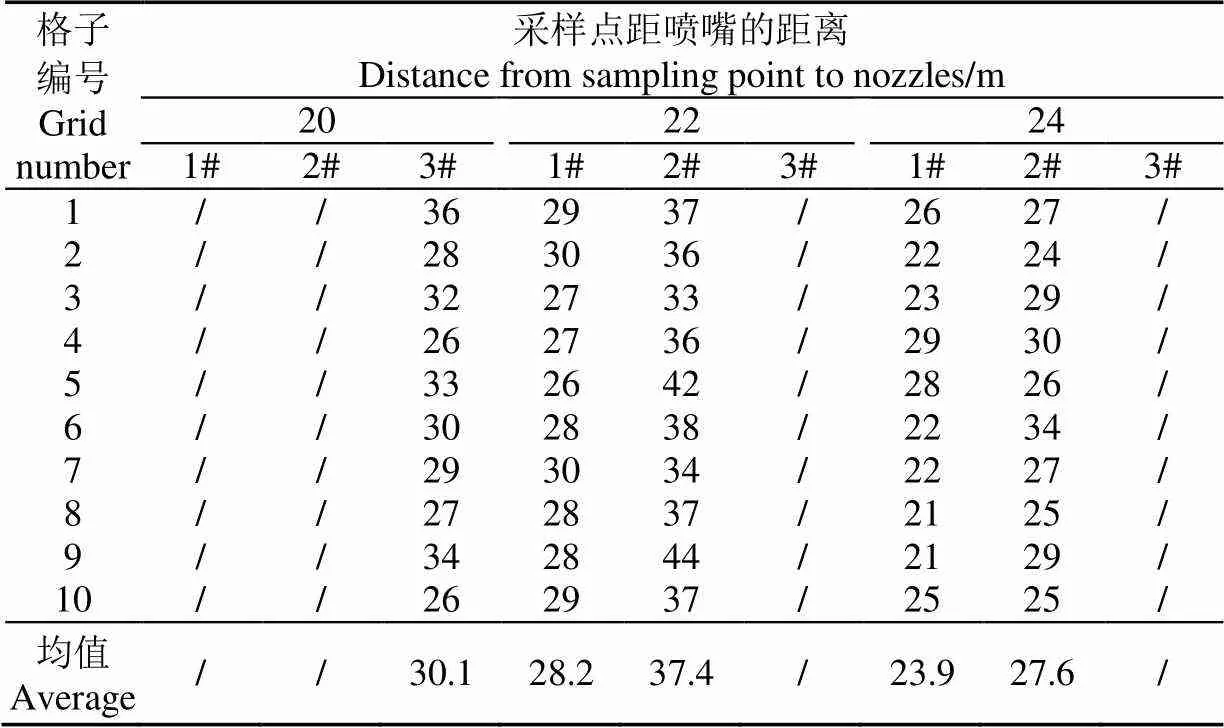
表3 采样纸卡的雾滴个数
注:1#、2#、3#分别表示第1次、第2次、第3次采样;“/”表示格子中雾滴数远远大于25滴。
Note:1#, 2# and 3# were the first, second and third test, respectively. “/” indicates that the number of droplets in the grid is far greater than 25 drops.
由表3可看出,远射程喷雾机的作业幅宽在22 m左右。说明了在无外界阻挡物时,风送式喷雾机的雾滴可以到达的对水平靶标的有效覆盖范围为22 m。
3 讨 论
3.1 环境风速与定位网架对测量结果的影响
试验环境风速对远射程风送式喷雾机空间风场特性及喷雾特性的试验及测量具有较大的影响,为此,本文在每次试验前,均多次测量环境风速,保证试验结果可信。
本文利用定位网架进行空间气流速度采样点的定位,定位网架的铁丝可以视为流场中的圆柱体,半径为1.25 mm,测量时,风速计在来流方向上距离定位网架20 mm。根据文献[31],距流场中圆柱体(圆柱体半径0)距离处,圆柱体对流场流速的影响系数为(0/)2,由此计算出本文试验中定位网架铁丝对风速的影响系数为:(1.25/20)2=3.9×10-3,故定位网架对流场的干扰可以忽略。
3.2 研究内容与实际作业之间的关系
本文的试验是对远射程风送式喷雾机的空间风场和喷雾性能的相关特性试验研究,其试验方法参照文献[29]中的“4.1.1水平射程、喷幅、垂直射程的测定”进行。
远射程风送式喷雾机在实际作业时,若作业区域为平地,喷筒轴线一般为水平;若作业区域为坡地,喷筒轴线一般与坡地保持平行,即喷雾机在坡底作业时,则喷筒轴线应为仰角;在坡顶作业时,喷筒轴线则为俯角。
无论水平作业还是坡地作业,喷筒的轴线均与作业面为平行,故本文的试验对研究远射程风送式喷雾机沿坡面作业时的空间风场及喷雾特性有一定的参考意义。
受重力场的影响,坡地作业中雾滴的沉降和沉积规律与水平作业时可能有所不同,因此,远射程风送式喷雾机喷筒在不同俯仰角下的雾滴沉积规律及喷雾效果还需进一步研究。
4 结 论
本文以远射程风送式喷雾机为试验样机,分别研究了其风场的空间特性和喷雾特性,并得到以下结论:
1)远射程风送式喷雾机轴心上的纵向时均风速随采样点距喷嘴距离的增加而衰减,两者呈负对数关系,这一特征符合淹没射流的流速变化规律;
2)远射程风送式喷雾机轴心方向同一采样点上的风速与风机供电频率之间呈线性正相关,决定系数最低为0.609 1;
3)远射程风送式喷雾机的水平喷幅关于喷筒轴心方向左右对称,呈无固壁约束的自由湍流特性,水平喷幅最大值为2.29 m,出现在=10 m处,而垂直喷幅关于喷筒轴心上下方向出现了不对称;
4)远射程风送式喷雾机的送风量与风机供电电源的频率成正比,出风口气流的时均风速与风机供电电源的频率也成线性关系。
远射程风送式喷雾机在水平喷雾时,喷筒轴线与地面平行,气流在空间的伯努利效应和附壁效应较为明显,采用喷筒仰角喷雾可削弱此效应的影响。本文的研究结果,可为远射程风送式喷雾机的生产和使用提供理论基础与技术指导。
[1] 尤勇. 植保技术与机械发展现状[J]. 南方农机,2010(4):24-25.
[2] 宋淑然,洪添胜,孙道宗,等. 风送式喷雾机变速喷雾雾滴沉积试验[J]. 农机化研究,2009,31(1):166-169.
Song Shuran, Hong Tiansheng, Sun Daozong, et al. Droplet deposition in variable-speed spraying experiment of air blast sprayer[J]. Journal of Agriculture Mechanization Research, 2009, 31(1): 166-169. (in Chinese with English abstract)
[3] 傅锡敏,吕晓兰,丁为民. 我国果园植保机械现状与技术需求[J]. 新疆农机化,2011(1):61-63.
Fu Ximin, Lü Xiaolan, Ding Weimin. Present state and technical requirment about orchard plant protecion machinery in China[J]. Xinjiang Agriculture Mechanization, 2011(1): 61-63. (in Chinese with English abstract)
[4] 张发军,彭军,李睿远. 6WC-30Y-G型车载式超低容量喷雾机的研制[J]. 林业机械与木工设备,2006,34(3):16-18.
Zhang Fajun, Peng Jun, Li Ruiyuan. Design and experiment on the 6WG-30Y-G mode truck-mounted especial low-volume sprayer[J]. Forestry Machinery & Woodworking Equipment, 2006, 34(3): 16-18. (in Chinese with English)
[5] 欧亚明,刘青. 轴流式风机在风送式喷雾机上的选型与计算[J]. 中国农机化,2004(2):24-25.
Ou Yaming, Liu Qing. Selection and calculation of axial flow fan on the air-blast sprayer[J]. Chinese Agriculture Mechanization, 2004(2): 24-25. (in Chinese with English abstract)
[6] 刘青,傅泽田,祁力钧,等. 9WZCD-25型风送式超低量喷雾机性能优化试验[J]. 农业机械学报,2005,36(9):44-47.
Liu Qing, Fu Zetian, Qi Lijun, et al, Characteristics optimization experiments of 9WZCD-25 air-blast and ultra low volume sprayer[J]. Transactions of the Chinese Society for Agricultural Machinery, 2005, 36(9): 44-47. (in Chinese with English abstract)
[7] 宋淑然,阮耀灿,洪添胜,等. 宽喷幅风送式喷雾机扩幅喷筒优化设计及试验[J]. 农业工程学报,2013,29(18):34-42.
Song Shuran, Ruan Yaocan, Hong Tiansheng, et al. Optimal design and test on expanding duct of wide-swath air-blast sprayer[J]. Transactions of the Chinese Society of Agricultural Engineering (Transactions of the CSAE), 2013, 29(18): 34-42. (in Chinese with English abstract)
[8] 李超,张晓辉,姜建辉,等. 葡萄园立管风送式喷雾机的研制与试验[J]. 农业工程学报,2013,29(4):71-78.
Li Chao, Zhang Xiaohui, Jiang Jianhui, et al. Development and experiment of riser air-blowing sprayer in vineyard[J]. Transactions of the Chinese Society of Agricultural Engineering (Transactions of the CSAE), 2013, 29(4): 71-78. (in Chinese with English abstract)
[9] 刘秀娟,郑加强,周宏平. 喷筒结构对风送式喷雾机射流动力的影响[J]. 中国农机化,2012(2):106-109.
Liu Xiujuan, Zheng Jiaqiang, Zhou Hongping. Jet dynamics and spraying nozzle structure of air-assisted sprayer[J]. Chinese Agricultural Mechanization, 2012(2): 106-109. (in Chinese with English abstract)
[10] Dekeyser D, Duga AT, Verboven P, et al. Assessment of orchard sprayers using laboratory experiments and computational fluid dynamics modelling[J]. Biosystems Engineering, 2013, 114(2): 157-169.
[11] Salcedo R, Granell R, Palau G, et al. Design and validation of a 2D CFD model of the airflow produced by an airblast sprayer during pesticide treatments of citrus[J]. Computers and Electronics in Agriculture, 2015(116): 150-161.
[12] 吕晓兰,张美娜,常有宏,等. 果园风送喷雾机导流板角度对气流场三维分布的影响[J]. 农业工程学报,2017,33(15):81-87.
Lü Xiaolan, Zhang Meina, Chang Youhong, et al. Influence of deflector angles for orchard air-assisted sprayer on 3D airflow distribution[J]. Transactions of the Chinese Society of Agricultural Engineering (Transactions of the CSAE), 2017, 33(15): 81-87. (in Chinese with English abstract)
[13] 戴奋奋. 风送喷雾机风量的选择与计算[J]. 植物保护,2008(6):124-127.
Dai Fenfen. Selection and calculation of the blowing rate of air-assisted sprayers[J]. Plant Protection, 2008(6): 124-127. (in Chinese with English abstract)
[14] 何雄奎,曾爱军,何娟. 果园喷雾机风速对雾滴的沉积分布影响研究[J]. 农业工程学报,2002,18(4):75-77.
He Xiongkui, Zeng Aijun, He Juan. Effect of wind velocity from orchard sprayer on droplet deposit and distribution[J]. Transactions of the Chinese Society of Agricultural Engineering (Transactions of the CSAE), 2002, 18(4): 75-77. (in Chinese with English abstract)
[15] 崔志华,傅泽田,祁力钧,等. 风送式喷雾机风筒结构对飘移性能的影响[J]. 农业工程学报,2008,24(2):111-115.
Cui Zhihua, Fu Zetian, Qi Lijun, et al. Effect of the air duct medication on the spray drift emitted by an air-assisted sprayer[J]. Transactions of the Chinese Society of Agricultural Engineering (Transactions of the CSAE), 2008, 24(2): 111-115. (in Chinese with English abstract)
[16] 傅泽田,王俊,祁力钧,等. 果园风送式喷雾机气流速度场模拟及试验验证[J]. 农业工程学报,2009,25(1):69-74.
Fu Zetian, Wang Jun, Qi Lijun, et al. CFD simulation and experimental verification of air-velocity distribution of air-assisted orchard sprayer[J]. Transactions of the Chinese Society of Agricultural Engineering (Transactions of the CSAE), 2009, 25(1): 69-74. (in Chinese with English abstract)
[17] 宋淑然,洪添胜,刘洪山,等. 宽喷幅风送式喷雾机空间气流速度分布规律[J]. 农业工程学报,2013,29(24):17-24.
Song Shuran, Hong Tiansheng, Liu Hongshan, et al. Law of spatial airflow velocity distribution for wide-swath air-blast sprayer[J]. Transactions of the Chinese Society of Agricultural Engineering (Transactions of the CSAE), 2013, 29(24): 17-24. (in Chinese with English abstract)
[18] Osterman A, Godesa T, Hocevar M, et al. Real-time positioning algorithm for variable-geometry air-assisted orchard sprayer[J]. Computers and Electronics in Agriculture, 2013, 98: 175-182.
[19] Pergher G, Gubiani R, Cividino S R, et al. Assessment of spray deposition and recycling rate in the vineyard from a new type of air-assisted tunnel sprayer[J]. Crop Protection, 2013. 45(3): 6-14.
[20] Khot L R, Ehsani R, Maja J M. Evaluation of deposition and coverage by an air-assisted sprayer and two air-blast sprayers in a citrus orchard[J]. Transactions of the ASABE, 2014, 57: 1007-1013.
[21] Ramon Salcedo, Cruz Garczera, Rafael Granell, et al. Description of the airflow produced by an air-assisted sprayer during pesticide applications to citrus[J]. Spanish Journal of Agricultural Research. 2015, 13(2): 1-15.
[22] 李龙龙,何雄奎,宋坚利,等. 果园仿形变量喷雾与常规风送喷雾对比试验[J]. 农业工程学报,2017,33(16):56-63.
Li Longlong, He Xiongkui, Song Jianli, et al. Comparative experimental study on profile variable rate spray and conventional air assisted spray in orchards[J]. Transactions of the Chinese Society of Agricultural Engineering (Transactions of the CSAE), 2017, 33(16): 56-63. (in Chinese with English abstract
[23] Vanella G, Salyani M, Balsari P. Spray interactions with a windbreak netting used in orchard applications[J]. Crop Protection, 2013, 44: 95-103.
[24] 宋淑然,洪添胜,孙道宗,等. 风机电源频率对风送式喷雾机喷雾沉积的影响[J]. 农业工程学报,2011,27(1):153-159.
Song Shuran, Hong Tiansheng, Sun Daozong, et al. Effect of fan power supply frequency on deposition of air-assisted sprayer[J]. Transactions of the Chinese Society of Agricultural Engineering (Transactions of the CSAE), 2011, 27(1): 153-159. (in Chinese with English abstract)
[25] Khot Lav R, Ehsani Reza, Maja Joe Mari J, et al. Evaluation of deposition and coverage by an air-assisted sprayer and two air-blast sprayers in a citrus orchard[J]. Transactions of the ASABE, 2014, 57(4): 1007-1013.
[26] Marcello Biocca, Pietro Gallo. Comparison between horizontal and vertical lamellate patternators for air-blast sprayers[J]. The Open Agriculture Journal, 2014, 8: 12-17.
[27] Zyl J G V, Grout T G, Schutte G C, et al. Reduced volume spray application in South African citrus orchards: Effects on deposition quantity, quality and uniformity[C/OL]// SuproFruit 2015–13th Workshop on Spray Application in Fruit Growing, Lindau, Germany, July 15-18, 2015. Germany: Julius- Kühn-Archiv, 2015, 448: 51-52. http://pub.jki.bund.de/index.php/JKA/article/view/4756/4566
[28] 宋淑然,夏侯炳,卢玉华,等.风送式喷雾机导流器结构优化及试验研究[J]. 农业工程学报,2012,28(6):7-12.
Song Shuran, Xia Houbing, Lu Yuhua, et al. Structural optimization and experiment on fluid director of air-assisted sprayer[J]. Transactions of the Chinese Society of Agricultural Engineering (Transactions of the CSAE), 2012, 28(6): 7-12. (in Chinese with English abstract)
[29] 中华人民共和国工业和信息化部. JB/T9782-2014,植保机械-通用试验方法[S]. 北京:中国质检出版社,2014.
Ministry of Industry and Information Technology of the People’s Republic of China. JB/T9782-2014, Equipment for crop protection-General test methods[S]. Beijing: China Quality Inspection press, 2014. (in Chinese with English abstract)
[30] 宋淑然,陈建泽,洪添胜,等.远射程风送式喷雾机风场中雾滴粒径变化规律[J]. 农业工程学报,2017,33(6):59-66.
Song Shuran, Chen Jianze, Hong Tiansheng, et al. Variation of droplet diameter in wind field for long-range air-assisted sprayer[J]. Transactions of the Chinese Society of Agricultural Engineering (Transactions of the CSAE), 2017, 33(6): 59-66. (in Chinese with English abstract)
[31] 罗惕乾,程兆雪,谢永曜. 流体力学[M]. 北京:机械工业出版社,2007.
Test on airflow field and spray characteristics for long-range air-blast sprayer
Chen Jianze1, Song Shuran2,3,4,5※, Sun Daozong2,3,4,5, Hong Tiansheng1,3,4,5, Zhang Long2
(1.510642,; 2.510642,; 3.510642,; 4.510642,; 5.510642,)
When the long-range air-blast sprayer is carrying out spraying, droplets are sent to the distant targets by the high speed air flow from fan. At the same time, the air flow in spatial wind field will blow the targets and shake the target branches, which allows droplets attachment to the back and surface of leaves of target crops as well as the surface and inner of the fruit tree canopy. It has been reported that the deposition and distribution of droplets on the fruit trees are mainly affected by blowing volume of air-blast sprayer fan, which is determined by the wind speed of the fan. Therefore, the characteristics of wind field with air-blast sprayer and the variations of wind speed will directly affect the control effects on pests and diseases in orchards. Scholars from China and other countries have done much research on the air-assisted sprayer in orchards. The range of the sprayer is relatively short, which can be applied to the orchard plant protection in plain areas. In addition, in the research on the long-range air-blast sprayer (also called cannon sprayer), most of them focus on the penetrativity, deposition and distribution of droplets, optimal designs of sprayer and variations of droplet diameter. Based on above, the study in this paper focused on spatial wind field and spray characteristics for long-range air-blast sprayer. As the prototype for testing, the long-range air-blast sprayer is equipped with 10 hollow-cone type nozzles distributed circumferentially, which are evenly distributed on the round outlet edge of spray-duct. The followings are the instruments and equipments used in the test: AZ-8901 anemometer with wind speed measurement range of 0.4-35 m/s, resolution of 0.01 m/s, and accuracy of ±2%; wind speed measurement positioning frame (homemade) which is 3 m high and 2 m wide and its grid size is 11 cm × 11 cm with a wire radius of 1.25 mm; a digital microscope with a magnification from 1 to 300. With the wind speed measurement positioning frame, the tests on the characteristics of spatial wind field for long-range air-blast sprayer and on the spraying width were carried out. The wire of sampling frame can be regarded as the cylinder in the flow field. When measuring, the anemometer was 20 mm away from the sampling frame in the direction of incoming flow. Thus, the influence coefficient of wire on wind speed was calculated, which was 3.9×10-3. Therefore, the interference to the flow field caused by sampling frame can be neglected. At the same time, the wind speed in testing environment had a great influence on the test and the measurement of spatial wind field and spray characteristics for long-range air-blast sprayer. Therefore, in order to ensure the reliability of the test results, repeated measurements of ambient wind speed have been carried out before each test. The test results showed that the vertical average wind speed on the axis of long-range air-blast sprayer decreased with the increase of distance between sampling point and nozzle and there was a negative logarithm relationship between them. This characteristic is in accord with the flow variations of submerged jet. The wind speed at the same sampling point in the axis direction of long-range air-blast sprayer was linearly and positively correlated to the power frequency of the fan with a high correlation coefficient. The horizontal spraying width of long-range air-blast sprayer was bilaterally symmetrical in the axial direction of spray-dust; in contrast, the vertical counterpart in the upper and lower axial direction of spray-dust was asymmetric. Bernoulli effect and Coanda effect resulted from entrainment are the important reasons for the formation of asymmetric vertical spraying width. However, the effects can be eliminated by spraying with an angle of elevation. By measuring the average wind speed at the outlet of air duct, the blowing volume was calculated. The result showed that the blowing volume of long-range air-blast sprayer and the average speed of flow at the outlet were proportional to the frequency of the fan. The sampling card method was adopted to measure the horizontal operation width of the sprayer and the width of the experimental prototype was 22 m. The long-range air-blast sprayer can be applied not only to agricultural plant protection but also to dedusting spray and dust suppressing spray for environmental purification. The findings in the study provide theoretical basis and technical guidance for the production and application of the long-range air-blast sprayer.
agricultural machinery; spraying; wind speed; long-range; air-blast; spatial wind field; spray width; Coanda effect
10.11975/j.issn.1002-6819.2017.24.010
S224.3
A
1002-6819(2017)-24-0072-08
2017-08-03
2017-10-08
国家自然科学基金项目(31671591);广东省农业标准化研究项目粤质监标函{2016}【369】号;广州市科技计划项目(201607010362,201605030013);广东省科技计划项目(2015B090901031);“扬帆计划”引进创新创业团队专项(201312G06);现代农业产业技术体系建设专项资金(CARS-27)
陈建泽,男,广东珠海人,博士生,主要从事精准农业中的测试与控制技术研究,Email:jianzechen@qq.com
宋淑然,女,河北安国人,教授,博士,主要从事喷雾技术及测控技术研究。Email:songshuran@scau.edu.cn
中国农业工程学会高级会员:宋淑然(E041200222S)
陈建泽,宋淑然,孙道宗,洪添胜,张 龙. 远射程风送式喷雾机气流场分布及喷雾特性试验[J]. 农业工程学报,2017,33(24):72-79. doi:10.11975/j.issn.1002-6819.2017.24.010 http://www.tcsae.org
Chen Jianze, Song Shuran, Sun Daozong, Hong Tiansheng, Zhang Long. Test on airflow field and spray characteristics for long-range air-blast sprayer[J]. Transactions of the Chinese Society of Agricultural Engineering (Transactions of the CSAE), 2017, 33(24): 72-79. (in Chinese with English abstract) doi:10.11975/j.issn.1002-6819.2017.24.010 http://www.tcsae.org
